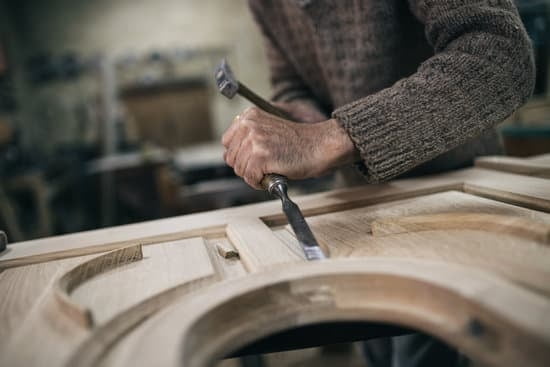When it comes to woodworking, having the right design software can make all the difference in creating precise and beautiful projects. Two popular options for woodworkers are Fusion 360 and Sketchup. Both of these powerful tools offer a range of features that can help streamline the design process and bring your woodworking ideas to life.
Whether you’re an experienced woodworker or just starting out, having a solid understanding of Fusion 360 or Sketchup can greatly benefit your woodworking projects. These software programs offer a wide range of tools and functions specifically tailored to woodworking, allowing you to create detailed and accurate designs for your projects with ease.
In this article, we will delve into the basics of both Fusion 360 and Sketchup, exploring how each program can be used for woodworking. We will also discuss the advantages of using each software in the context of woodworking projects, as well as providing valuable tips and tricks for getting the most out of Fusion 360 or Sketchup in your woodworking endeavors.
Whether you’re a hobbyist or professional woodworker, understanding the capabilities of these design tools can take your craftsmanship to the next level.
Understanding the Basics of Fusion 360 and Sketchup
Fusion 360 and Sketchup are both powerful design software that can be used for woodworking projects. Each program has its own unique tools and features that cater to the specific needs of woodworkers. Understanding the basics of these two programs is essential for anyone looking to use them in their woodworking projects.
Introduction to Fusion 360
Fusion 360 is a cloud-based 3D modeling software developed by Autodesk. It is commonly used by engineers and designers but has gained popularity among woodworkers due to its robust design tools and collaborative capabilities. With Fusion 360, woodworkers can create precise 3D models, generate detailed drawings, and simulate the assembly of their woodworking designs.
Introduction to Sketchup
Sketchup, on the other hand, is a user-friendly 3D modeling software developed by Trimble Inc. It is known for its intuitive interface and ease of use, making it a popular choice among hobbyists and professionals alike. Woodworkers can utilize Sketchup’s extensive library of pre-made components and plugins to quickly create accurate models of their woodworking projects.
Understanding the Basics
Both Fusion 360 and Sketchup offer a wide range of tools for creating detailed woodworking designs. From basic shapes to intricate joinery details, these programs allow woodworkers to visualize their projects in 3D before making any cuts. Learning how to navigate the user interface, create and edit components, and use measurement tools are essential skills for woodworkers using either Fusion 360 or Sketchup.
Regardless of whether you choose Fusion 360 or Sketchup for your woodworking projects, taking the time to familiarize yourself with the basics of each program will ultimately lead to more efficient and accurate design work in the long run.
Creating Woodworking Designs in Fusion 360
When it comes to creating woodworking designs, Fusion 360 offers a versatile and powerful platform for woodworkers to bring their projects to life. With its comprehensive set of tools, Fusion 360 allows users to design, visualize, and simulate their woodworking ideas with ease. Here are the basic steps for creating woodworking designs in Fusion 360:
1. Sketching: Fusion 360 provides a robust sketching environment where woodworkers can create 2D profiles of their designs. This feature allows for precise and customizable shapes that form the foundation of the woodworking project.
2. Extruding and Revolving: Once the sketch is complete, users can extrude or revolve the 2D profiles to create 3D solid models. This process enables woodworkers to give depth and dimension to their designs, turning them into tangible objects.
3. Joinery and Assembly: Fusion 360 offers various tools for creating joinery such as mortise and tenon joints, dovetails, and rabbets. Additionally, users can assemble multiple components together to ensure they fit seamlessly in the overall woodworking project.
By utilizing the capabilities of Fusion 360, woodworkers can easily translate their creative vision into detailed woodworking designs ready for production.
Overall, while both software options have their strengths and weaknesses, Fusion 360 stands out as a robust tool for all types of woodworking projects.
Creating Woodworking Designs in Sketchup
Sketchup is a popular 3D modeling software that has gained a significant following among woodworkers for its user-friendly interface and powerful features. When it comes to creating woodworking designs in Sketchup, there are several key elements to keep in mind.
Basic Tools and Functions
One of the first steps in creating woodworking designs in Sketchup is familiarizing yourself with the basic tools and functions. These include drawing lines, shapes, and using the push/pull tool to create 3D shapes. Understanding how to navigate the program, use the measuring tool, and create components are also essential skills for woodworking design in Sketchup.
Utilizing Plugins
Sketchup offers a wide range of plugins that can greatly enhance your woodworking design capabilities. Whether you need to generate complex shapes, create joinery details, or produce accurate cut lists, there’s likely a plugin available to streamline your workflow. Taking the time to explore and experiment with different plugins can significantly improve your efficiency and precision when designing woodworking projects.
Creating Detailed Plans and Renderings
Once you’ve mastered the basics of Sketchup for woodworking, you can start creating detailed plans and renderings of your designs. This may involve adding dimensions, annotations, and other relevant details to effectively communicate your vision. Additionally, using rendering plugins or built-in features can help you visualize the final product and make any necessary adjustments before beginning construction.
The Advantages of Using Fusion 360 for Woodworking
Fusion 360 is a powerful software that offers several advantages for woodworking projects. One of the key benefits of using Fusion 360 for woodworking is its integrated design and manufacturing capabilities. With Fusion 360, woodworkers can create detailed designs and seamlessly transition to the manufacturing phase by generating toolpaths for CNC machines. This integrated approach streamlines the entire woodworking process, allowing for greater efficiency and accuracy in the production of woodworking projects.
Another advantage of using Fusion 360 for woodworking is its parametric modeling capabilities. This feature allows woodworkers to easily make changes to their designs by simply adjusting parameters, without having to start from scratch. This level of flexibility is particularly useful in woodworking, where precise measurements and adjustments are often necessary. Additionally, Fusion 360 offers robust simulation tools that allow woodworkers to test their designs virtually, ensuring that they will function as intended once built.
Furthermore, Fusion 360 has collaborative features that make it ideal for woodworking teams or individuals working with clients. The software enables real-time collaboration and version control, allowing multiple users to work on the same project simultaneously.
This level of collaboration ensures that all stakeholders are on the same page throughout the design and manufacturing process. Overall, Fusion 360 provides woodworkers with a comprehensive set of tools and features that can greatly enhance the design and production of high-quality woodworking projects.
The Advantages of Using Sketchup for Woodworking
Sketchup is a powerful 3D modeling software that has gained popularity among woodworkers for its user-friendly interface and robust features. Here are some of the advantages of using Sketchup for woodworking projects:
- Intuitive Interface: One of the biggest advantages of using Sketchup for woodworking is its intuitive and easy-to-use interface. Woodworkers can quickly grasp the basics of the software and start creating their designs without a steep learning curve.
- Extensive Library of Plugins: Sketchup offers a wide range of plugins that cater specifically to woodworking needs. From joinery plugins to cutlist generators, woodworkers can enhance their workflow and streamline their design process with these useful tools.
- Community Support: Sketchup boasts a large community of users, including many woodworkers who share tips, tutorials, and resources. This makes it easier for beginners to learn the software and for experienced users to discover new techniques and best practices.
Overall, Sketchup’s simplicity, plugin options, and community support make it a valuable tool for woodworkers looking to create precise and detailed designs.
Whether you are a beginner or an experienced woodworker, Sketchup provides all the necessary features to bring your woodworking ideas to life in a digital environment. Its user-friendly interface, extensive library of plugins, and strong community support make it an excellent choice for anyone interested in leveraging technology as a part of their craft projects.
More than just a design tool, Sketchup is an indispensable asset that allows you to plan, visualize, and iterate on your woodworking projects with ease. With its convenient features tailored towards woodworking needs, this software truly stands out as an invaluable resource for any woodworking enthusiast looking to take their skills to the next level.
Tips and Tricks for Using Fusion 360 and Sketchup in Woodworking Projects
Woodworking projects can be greatly enhanced with the use of design software such as Fusion 360 or Sketchup. These tools offer a wide range of features to help woodworkers create precise and detailed designs, and there are several tips and tricks that can help maximize their potential in woodworking projects.
One important tip for using Fusion 360 or Sketchup in woodworking is to take advantage of the software’s built-in measurement tools. These tools allow woodworkers to accurately measure distances, angles, and dimensions within their designs, ensuring that all components fit together perfectly. Additionally, using layers in these programs can help keep designs organized, making it easier to focus on specific parts of a project without getting overwhelmed by unnecessary details.
Another useful tip is to explore the available plugins and extensions for Fusion 360 or Sketchup. Both programs have a wide range of plugins created by third-party developers that can add new functionality and tools to the software. For woodworking specifically, there are plugins available that assist with tasks such as creating complex joints, generating cut lists, or simulating how different materials will behave in a design.
Finally, when using Fusion 360 or Sketchup for woodworking, it’s important to take advantage of online tutorials and communities. Both programs have large communities of users who share tips, tricks, and resources that can help woodworkers improve their skills and efficiency with the software.
| Tips | Tricks |
|---|---|
| Use measurement tools for accuracy | Explore available plugins and extensions |
| Organize designs using layers | Take advantage of online tutorials and communities |
Comparison of Fusion 360 and Sketchup for Woodworking
When it comes to using design software for woodworking projects, two popular options are Fusion 360 and Sketchup. Both programs have their own unique features and advantages that cater to woodworkers with different needs and preferences.
Fusion 360 is a powerful software known for its parametric solid modeling capabilities, which allows users to create precise 3D models. It also offers integrated CAM (computer-aided manufacturing) functionality, making it a comprehensive tool for designing and manufacturing woodworking projects. Fusion 360’s ability to generate toolpath strategies directly from the 3D model can be particularly beneficial for woodworkers looking to streamline their production process.
On the other hand, Sketchup is valued for its user-friendly interface and intuitive tools, making it a great option for beginners or hobbyist woodworkers. Sketchup allows for quick and easy creation of 3D models, offering a more straightforward approach compared to Fusion 360. Additionally, Sketchup has a vast library of user-created extensions that can further enhance its functionality for woodworking-specific tasks such as creating intricate joinery or generating cut lists.
In terms of cost, both Fusion 360 and Sketchup offer free versions with limited functionalities as well as paid subscriptions that unlock advanced features. Woodworkers should consider their specific needs, level of expertise, and budget when deciding between the two software options. Ultimately, whether choosing Fusion 360 or Sketchup for woodworking will depend on individual preferences and project requirements.
Conclusion and Recommendations for Woodworkers Using Fusion 360 and Sketchup
In conclusion, both Fusion 360 and Sketchup have their unique advantages when it comes to woodworking design. Fusion 360 offers a high level of precision and a wide range of tools that are specifically tailored for woodworking projects.
Its parametric modeling capabilities allow woodworkers to make detailed adjustments and modifications to their designs, ensuring a perfect fit for their final product. On the other hand, Sketchup is known for its user-friendly interface and ease of use, making it an ideal choice for beginners or those who prefer a simpler approach to design.
For woodworkers looking for a more technical and precise approach to woodworking design, Fusion 360 may be the preferred choice. Its advanced features and integration with other CAD/CAM software make it a powerful tool for professional woodworkers who require complex designs and simulations. However, for hobbyists or those with less experience in CAD software, Sketchup’s intuitive nature and wealth of online resources make it a popular option for woodworking enthusiasts.
Ultimately, the decision between Fusion 360 and Sketchup will depend on the specific needs and preferences of each woodworker. It may even be beneficial to try both software programs to find which one best suits individual workflows. Regardless of which program is chosen, both Fusion 360 and Sketchup offer valuable tools and capabilities that can enhance the quality and efficiency of woodworking projects.
Frequently Asked Questions
Which Is Better for Woodworking Fusion 360 or SketchUp?
Both Fusion 360 and SketchUp have their strengths when it comes to woodworking. Fusion 360 is known for its parametric modeling capabilities, making it great for precise designs and engineering. On the other hand, SketchUp is praised for its user-friendly interface and quick conceptualization of designs.
Is Fusion 360 Used by Professionals?
Yes, Fusion 360 is widely used by professionals in various fields, including engineering, industrial design, architecture, and woodworking. Its advanced features such as simulation tools, cloud collaboration, and integrated CAM make it a popular choice among professionals who require complex design and manufacturing capabilities.
Is Fusion 360 Good for Woodworking?
Fusion 360 can be a good tool for woodworking due to its parametric modeling features that allow for precise and detailed design creation. It also has integrated CAM functionality which enables woodworkers to generate toolpaths for CNC machining directly from their designs.
Additionally, Fusion 360’s ability to handle complex assemblies and integrate with other software makes it a useful option for woodworking projects of all scales.

Hi everyone! I’m a woodworker and blogger, and this is my woodworking blog. In my blog, I share tips and tricks for woodworkers of all skill levels, as well as project ideas that you can try yourself.





